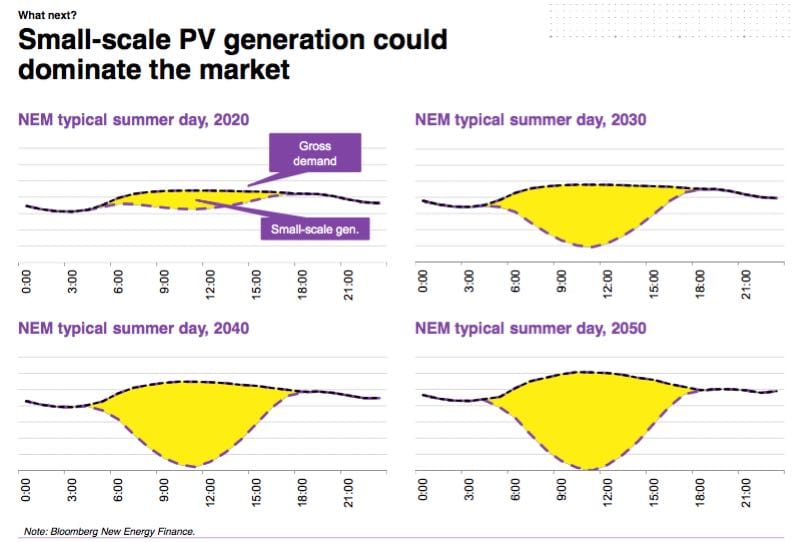The federal Coalition government on Wednesday demonstrated its extraordinary attachment to building new coal-fired power stations when it voted, en masse, to support a motion put forward by One Nation’s Pauline Hanson.
The motion was defeated in The Senate, but it highlighted how the whole government has now fallen in behind the push by the right wing elements for new coal-fired generation, to stop new wind and solar in their tracks, and to effectively abandon the Paris climate targets.
The push for a new coal generator makes no sense at all – on economics, environment, or even engineering grounds. Wind and solar is the cheapest form of new generation, the modern grid requires flexibility and dispatchability, and the climate targets must be met.
But the best argument of all against new coal-fired generators, or even extending existing ones, and one easily made by individual voters, may be the continued rapid uptake of rooftop solar.
Australian households and businesses are installing rooftop solar at record levels – already around 600MW in the first five months of the year, as the rate of penetration soars above 30 per cent in Queensland, South Australia and Western Australia.
Interest-free loans in Queensland, and possibly South Australia, and other innovative schemes are being introduced to make sure rooftop solar is available to low income households, renters, and apartment dwellers.
This really is power to the people, also known as energy democracy.
The boom in rooftop solar – BNEF sees the rate of installation remaining at more than 1GW for another 10 years – is likely to have a more equitable and reasonable outcome than the democratic process being exercised in Canberra.
In the grid, unlike parliament, every solar module added is a case against the future of coal generation.
This graph above was presented by Bloomberg New Energy Finance analyst Leonard Quong, at the Large Scale Solar and Storage conference co-hosted by RenewEconomy and Informa in Sydney on Wednesday.
It shows that by 2020, rooftop solar will already be making its presence felt during the middle of the day, as witnessed by the slump of prices into negative territory last week.
By 2040, Quong says, the amount of rooftop solar installed means that “native” grid demand will be eradicated at midday. By 2050, this will be negative most of the time.
This is not an outlying assessment. The Australian Energy Market Operator has suggested this could occur in states like South Australia and Western Australia within 10 years.
It is now generally accepted that “distributed energy” – including rooftop solar, battery storage, and smart technologies like demand management – will make up nearly half the grid by 2050, possibly as early as 2040.
AEMO says the transition to a decentralised grid will be rapid and inevitable. Network owners agree, hence their push to seek to “orchestrate” this resource so it can be managed in a changing grid.
Quong said the impacts of this would no doubt be mitigated by the amount of battery storage and flexible loads and demand management, part of the “behind the meter” assets that AEMO and the networks want to control.
But Quong’s main point was this:
“Looking at the market dynamics of this small scale PV generation, it is increasingly difficult to justify extending the life of a coal asset that relies on midday generation to stay viable.”
He says the negative prices witnessed recently in Queensland in the middle of the day, where there is more than 2GW of rooftop solar and an increasing amount of large-scale solar will become a more “pervasive” feature of the market.
And while large-scale wind and solar will likely be able to deal with this, because their energy costs will be lower and because storage options are emerging, coal will be crippled by its lack of flexibility.
“We expect almost all coal plants will exit the Australian market as they reach …. end of life considerations,” he said, noting the age of the plant, the cost of maintenance, and fuel supplies.
“If not pushed out, then certainly as they are run into the ground as they begin to become a reliability risk for the networks.”
And what about the case for a new coal-fired generator, as proposed by many Coalition MPs and, astonishingly, voted on by the entire Coalition Senate team on Wednesday when Hanson put up the motion?
The Coalition, and Hanson, and others, are operating under the delusion, spread by the likes of the Business Council of Australia, the Institute of Public Affairs, the Minerals Council, and the Murdoch media, that new coal would be cheaper than wind or solar.
This is BNEF’s assessment on the costs of new coal versus the cost of wind and solar. Coal is not even in the ball-park.
Even if you add in the cost of storage, renewables still beat coal with just one hour of storage, and by the time more storage is needed, even wind and solar with four hours of storage will beat both coal and gas.
So, carry on installing rooftop solar – and battery storage when you are happy that it makes economic sense. Every little bit is an argument against extending the life of existing generators, and investing in new ones.
If parliamentary democracy can’t deliver rational outcomes, then maybe energy democracy can.











